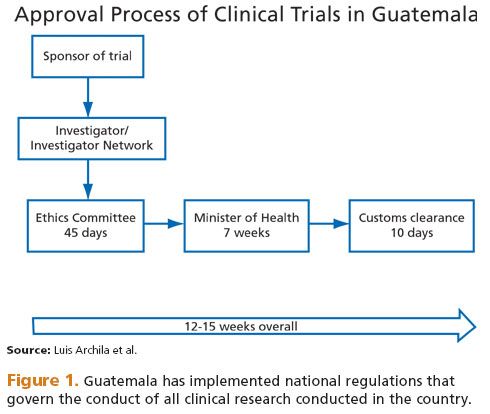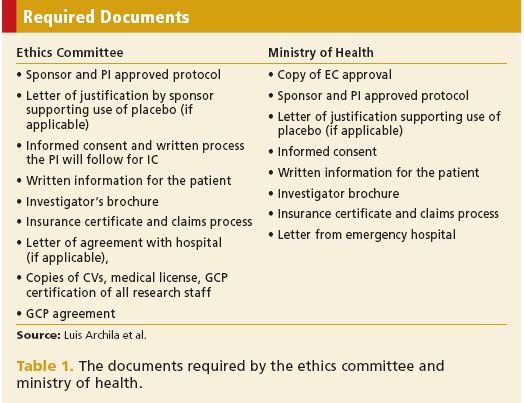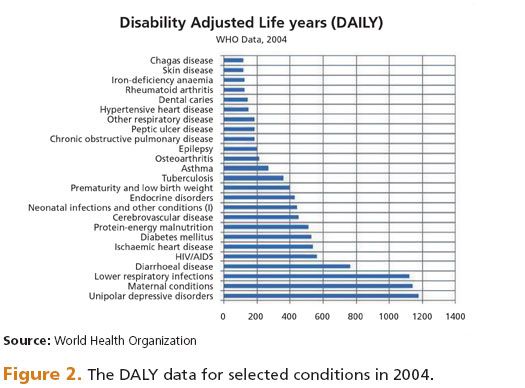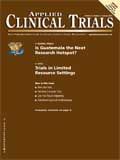Emerging Opportunity in Guatemala
Applied Clinical Trials
Guatemala is multi-ethnic, multilingual, and multi-cultural-ideal for international trials.
The forces shaping the landscape of clinical research are well known. The costs of drug development have increased significantly, and for a new drug candidate are now between $100 million and $800 million, perhaps higher.1 Clinical trials are reported to now constitute nearly 60% of total development costs.2 In addition to costs, development times are still long. Almost 80% of clinical trials do not complete on time,3 with clinical trial development averaging seven years.4 Of the many drivers contributing to the increase in time, one of the more challenging is recruiting patients who meet the eligibility criteria of the study.5 A recent analysis found less than one-third (31%) of trials achieved their original recruitment targets, with over 50% of all trials needing an extension of time.6 Multiple other forces are at play; for example, trials have become more complex as evidenced by the increase in the number of procedures per study7 and the increase in the number of patients enrolled per study.2 In addition, the demand for qualified investigators and research personnel is high. Thus, ready access to patients is critical. Our research and experience indicates that Guatemala is a country that offers many advantages for clinical research.

Because of factors such as those above, a significant number (up to 65%) of clinical trials are projected to be placed outside the United States by 2012, principally in Central and Eastern Europe, Latin America, and Asia.8 This shift is being driven in large part by economic advantages and access to large numbers of treatment-naïve patients. It is also fueled by the emergence of qualified investigators and the implementation of regulatory standards governing clinical trials.9
Latin America offers a particularly attractive venue for clinical studies. Recent articles have explored the benefits of conducting research in its 21 countries containing nearly 570 million people.10 Today, Latin America has a large and growing community of experienced and highly capable investigators. Across the region, countries have established effective ethics committees to ensure patient safety and have implemented proactive good clinical practice (GCP) policies. However, the most compelling benefits for doing research in Latin America are related to the very attractive environment it provides for recruitment due to:10
- Large, ethnically diverse populations due to native peoples as well as past immigration from Europe, Asia, and Africa.
- Availability of treatment-naïve patients across a broad range of therapeutic areas.
- Complementary to northern hemisphere locations for indications with seasonal variations.
- Strong patient-doctor relationships which lead to good compliance and minimal dropout rates.
Several Latin American countries are either currently involved in clinical research from United States and international sponsors or are becoming significantly so. The largest numbers of clinical trials being placed in Latin America are in Brazil, Argentina, and Mexico,9 often driven by access to a broad range of potential study participants in densely-populated cities of Sao Paulo, Rio de Janeiro, Buenos Aires, and Mexico City. We have found that additional countries in Latin America should be considered when placing trials as they offer advantages. Though they may not have mega-sized cities, these other countries have large population centers and in some cases offer ready access to more rural regions which enable contact with an even broader subject population. We describe a number of factors relevant to conducting trials in Guatemala.
Guatemala background
The country has a population of approximately 14 million people; over 60% are younger than 20 years of age.11 This young, poor, and mixed urban/rural population is growing at approximately 2.2% annually.12 Guatemala experiences difficult socioeconomic conditions with per capita GNI estimated at $2,620.13 It has one of the highest infant mortality rates and one of the lowest life expectancies at birth of any country in Latin America.14 Because the country spans the Caribbean and Pacific Oceans, with expansive lowlands as well as substantial mountainous and volcanic regions, Guatemala experiences a diverse range of climates; its rainy season extends from May to October and plays an important role in the prevalence of infectious diseases.
Guatemala City is readily accessible and is only about a two-hour flight from cities located in the southern United States. Guatemala's location in the Central Time zone of the United States means that communication with research sites can be done within normal working hours from anywhere in the continental United States.
Guatemala is a multi-ethnic, multi-lingual, and multi-cultural country. Mixed Amerindian-Spanish and European make up 59.4% of the population; other ethnic groups include K'iche (9.1%), Kaqchikel (8.4%), Mam (7.9%), Q'eqchi (6.3%), other Mayan (8.6%), indigenous non-Mayan (0.2%), and other (0.1%).15
The culture of the country reflects both Mayan and Spanish influences, which are somewhat separated by geography (rural and urban, respectively). The government is a constitutional democratic republic and its officials are popularly elected.
Regulatory environment
The regulatory environment in Guatemala is similar to that which has been reported for other countries in Latin America.10 The country has implemented national regulations (known as Normativa Regulación Ensayos Clínicos en Humanos16 ) governing the conduct of clinical research, which follow ICH good clinical practice. These regulations govern the conduct of all clinical research conducted in the country. The process is outlined in Figure 1.

As is common in other Latin American countries, Guatemala has a national research ethics committee which meets weekly in Guatemala City. The regulations require a number of documents to be submitted to the ethics committee in Spanish and English, which are listed in Table 1. The ethics committee is required to provide a response to the sponsor within 45 business days. Following the ethics committee review, a copy of the ethics committee approval plus the additional documents, in Spanish and English, must be submitted to the Minister of Health. The Minister of Health is required to provide a response to the sponsor within seven weeks. It typically requires 10 days for clinical samples shipped into the country to clear customs. Overall the regulatory process in Guatemala can be expected to take from 12 to 15 weeks.

Access to medical care
Approximately 20% of the population lacks effective access to health services17 and less than 60% of the population has the benefit of some form of health service coverage, which has not increased substantially since 1990.18 There are three medical schools in the country, and on average there are 0.9 physicians per 1,000 people (compared to 2.3 in the United States). The full range of medical care is available in Guatemala City, but medical care outside the city is limited. Guatemala's public hospitals frequently experience serious shortages of basic medicines and equipment. The largest public hospital in Guatemala City is Roosevelt Hospital, affiliated with the University of San Carlos School of Medicine. Care in private hospitals is generally adequate for most common illnesses and injuries, and many of the medical specialists working in them are US trained and certified.
GCP training in Guatemala
There is an established GCP training program which serves the research community of Guatemala. The training is offered annually, though the government requires only a single successful completion of training.
National Center for Epidemiology
One of the advantages of doing clinical work in Guatemala is the data-rich national epidemiology database that is maintained by the Epidemiological Monitoring System (SINAVE).19 This database is a valuable source of information on disease prevalence and incidence for clinical trial planning purposes. This government organization is in charge of the monitoring and analysis of acute infectious diseases such as those transmitted by food, water, and vector. It utilizes a network of reporting stations located throughout the 26 health districts in the country to monitor, collect, and analyze data on a variety of infectious diseases such as malaria, cholera, encephalitis, meningitis, diphtheria, measles, severe respiratory disease, typhoid fever, and dysentery. Data are reported to the National Epidemiology Center in Guatemala City where much of it can be accessed online through searchable databases. Data are generally updated weekly.
We have used epidemiology data to research incidence rates of dengue fever in children and identify specific communities within the country that have experienced high and relatively constant rates of the disease for protracted periods of time; such information is of great value in planning research (e.g., vaccines) because the natural fluctuation in disease rates is a significant complicating factor.
Disease burden/prevalence/incidence
Like many Latin American countries, Guatemala is in transition from infectious to chronic diseases as major sources of morbidity and mortality in the general population as urbanization occurs.14, 20 Over the past several decades there has been an increase in the incidence of diseases often associated with urban lifestyles and diets higher in saturated fat and sugar and lower in fiber. In more rural areas there is still a prevalence of infectious, water-borne, and vector-borne diseases. The juxtaposition of these diseases combined with a large treatment-naïve population creates a fertile environment in Guatemala for many types of clinical trials.
To provide a more quantitative view of the health status of the people in Guatemala, Figure 2 provides the disability adjusted life years (DALY) data for selected conditions for 2004 as reported by WHO.21 DALY is a measure of overall disease burden used in public health, expressed as the number of years lost due to ill-health, disability, or early death; one DALY unit is equal to one year of healthy life lost. Inspection of the data in Figure 2 reveals many disease states of significant interest to those in pharmaceutical development. Among the top ranked non-communicable diseases according to data from the World Health Organization using this index are: depression, heart disease, diabetes mellitus, and cerebrovascular diseases. The leading causes of death are cardiovascular disease, infectious and parasitic disease (dominated by diarrhea, turberclosis, and HIV/AIDS), malignant neoplasms, lower respiratory tract infections, neonatal conditions, diabetes mellitus, and malnutrition.22

Of more direct relevance for clinical trial planning purposes are incidence and prevalence data. A sampling of these data is presented here. From a study by the Pan American Health Organization in 2007 in the town of Villa Nueva located near Guatemala City, it was reported that the prevalence of diabetes was 8.4% across adults aged 20 and older, but rising to over 20% by age 50.20 This prevalence rate is comparable to that in the United States23 or Mexico.24 Importantly, almost half of the cases in the Villa Nueva study involved newly diagnosed patients as a result of this survey. The same study reported the prevalence of hypertension at 13% (adults, aged 20 years and older). In adults over 40 years, 30% were found to be hypertensive, with almost 9% suffering from stage 2 hypertension. A 2000 study, "National Survey on Living Conditions," found that the prevalence of overweight adult women was 48% and in men it was 34%.20 Other conditions with high prevalence include iron-deficient anemia, asthma, Chagas disease, and osteoarthritis.22
Communicable diseases with high incidence rates include diarrhea, hepatitis A, typhoid fever, dengue fever, malaria, and leptospirosis.22 For example, Goldman et al. reported the prevalence of diarrhea of approximately 22% for children under 5 years of age when analyzing data from the 1995 Guatemalan Survey of Family Health.25 Our own research indicates, that within specific communities, diarrhea rates (self reported within past two weeks) in excess of 60%. Due to high poverty rates and poor quality of diets, there are also high numbers of children suffering from malnutrition in certain regions of the country.14
Additional considerations
While Guatemala offers an untapped resource for a variety of clinical studies, there are several areas that must be addressed in conducting research. Guatemala has one of the lowest literacy rates (69% in adults, aged 15 years and older)15 in Latin America. Therefore, it is important that rigorous steps be put in place to ensure all potential participants fully understand the study and can provide true informed consent. Literacy must also be considered to ensure subjects comply with protocols and other instructions. Explaining procedures in a patient's native language can be important if a language other than Spanish is native to a patient. In addition, independent (of the study and patient) witnessing of the informed consent process helps safeguard patient's well-being. The research ethics committee itself monitors every study to ensure compliance with informed consent as well as protocol. In Latin America, patients tend to strongly rely on the recommendations of their physicians when making decisions about their or their family's health. There is the possibility that this could lead to participation in a study without questioning or feeling the need to personally understand the informed consent requirements. The recent revelations of medical misconduct involving unethical clinical research on non-volunteer subjects in Guatemala by members of the US Public Health Service in the 1940s, a tragedy closely related to the Tuskegee affair, is a stark reminder of the absolute importance of regulations governing clinical research and unwavering adherence to informed consent. On the other hand, if properly conducted, clinical research can bring substantial benefits to people in need, as evidenced by results from Poland, where up to 30% of hospital cancer therapy is funded by clinical trial sponsors.26
There are other areas to keep in mind as well. Within the major cities, high-speed internet and cell phone coverage is more than adequate to support research. Many (but not all) investigators and study coordinators are also conversant in English, facilitating communication. The country can experience occasional power and transportation disruptions due to tropical storms, so back up power generation is recommended.
Conclusions
Guatemala offers a number of benefits for conducting clinical work. These include:
- A proper regulatory environment and national regulations governing the conduct of clinical research following ICH good clinical practice.
- A relatively efficient regulatory review process.
- A growing pool of research physicians and an established training program for good clinical practice.
- Cooperation from both local and national governmental organizations, for example, the National Center for Epidemiology.
- Large numbers of treatment-naïve patients across a spectrum of globally relevant disease states.
- Strong, trusted physician-patient relationship that is prevalent across the country contributes to a high level of willingness to participate in clinical studies. Our own experience is that this facilitates recruitment and leads to a high level of compliance and retention during the course of a trial.
- Easy access from the United States and South America.
There are a number of current studies being conducted in the country-evidence that pharmaceutical companies are pursuing research in Guatemala. At the time of the writing of this article the FDA database listed over 40 studies actively recruiting patients in Guatemala for research on a diverse range of diseases including: type II diabetes, cardiovascular disease, hypertension, leukemia, malnutrition, vaccine trials, pulmonary diseases, depression, asthma, stroke, arthritis, pneumonia, travelers' diarrhea, and breast cancer. Such a spectrum of investigations is possible due to the fact that Guatemala is in transition from infectious to chronic diseases as major sources of morbidity and mortality. The juxtaposition of these diseases combined with a large treatment-naïve population creates a fertile environment in Guatemala for many types of clinical trials.
Luis Archila, DDS, is a Research Dentist in Guatemala. Raul Barrera, MD, Jeremias Guerra, MD, Alfredo Menegazzo, MD and Luis F. Perez-Martini, MD, are physicians in Guatemala. Stephen McClanahan,* PhD, is a retired clinical researcher in the United States, e-mail: mcclanahan.sf@gmail.com
*To whom all correspondence should be addressed.
References
1. R. Fee, "The Cost of Clinical Trials," Drug Discovery & Development, 10 (3) 32 (2007).
2. J. A. DiMasi, R. W. Hansen, and H. G. Grabowski, "The Price of Innovation: New Estimates of Drug Development Costs," Journal of Health Economics, 22 (2) 151-185 (2003).
3. Bio/Pharmaceutical R&D Statistical Sourcebook 2009/2010, "Clinical Trial Facts & Figures for Health Professionals," http://www.ciscrp.org/professional/facts_graphs.html.
4. K. I. Kaitin et al., "Outlook 2010," Tufts Center for the Study of Drug Development, http://csdd.tufts.edu/_documents/www/Outlook2010.pdf.
5. F. Kermani and P. Bonacossa, "New Ways to Recruit Trial Subjects," Applied Clinical Trials, 12 (2) 38-42 (2003).
6. A. M. McDonald, et al., "What Influences Recruitment to Randomized Controlled Trials? A Review of Trials Funded by Two UK Funding Agencies," Trials 7 (9) (2006).
7. Tufts Center for Drug Development, "A Comparison of Protocol Characteristics Over Time Shows Complexity is on the Rise," Applied Clinical Trials Online, November 1, 2010, http://appliedclinicaltrialsonline.findpharma.com/appliedclinicaltrials/Data+Analysis/A-Comparison-of-Protocol-Characteristics-Over-Time/ArticleStandard/Article/detail/693546/.
8. K. I. Kaitin et al., "Outlook 2009," Tufts Center for the Study of Drug Development, http://csdd.tufts.edu/_documents/www/Outlook2009.pdf.
9. J. Carvalho and E. Ibia, "Keys to Drug Development in Latin America," Applied Clinical Trials Online, October 1, 2009, http://appliedclinicaltrialsonline.findpharma.com/appliedclinicaltrials/Online+Extras/Keys-to-Drug-Development-in-Latin-America/ArticleStandard/Article/detail/630600?contextCategoryId=44907.
10. O. R. Nievas and S. G. Schefler, "Trials in Latin America," Applied Clinical Trials, 19 (7) 52-55 (2010).
11. Instituto Nacional de Estadistica, 2002 Guatemalan census data.
12. Google Public Data Explorer, "World Bank, World Development Indicators," http://www.google.com/publicdata?ds=wb-wdi&met=sp_pop_grow&idim=country:GTM&dl=en&hl=en&q=guatemala+population+growth+rate.
13. The World Bank, "Data on Guatemala," http://data.worldbank.org/country/guatemala/ (assessed November 5, 2010).
14. M. Gragnolati and A. Marini, "Health and Poverty in Guatemala," World Bank Policy Research Working Paper 2966, January 2003, http://papers.ssrn.com/sol3/papers.cfm?abstract_id=636328.
15. Central Intelligence Agency, "The World Factbook," https://www.cia.gov/library/publications/the-world-factbook/geos/gt.html.
16. Ministerio de Salud Publica Y Asitencia Social, "Acuerdo Ministerial SP-M-466-2007," http://portal.mspas.gob.gt/images/files//Marco%20Legal/Salud%20Publica/AM_SP_M_466_2007.pdf.
17. World Health Organization, "Country Cooperation Strategy at a Glance-Guatemala," May 2007, http://www.who.int/countryfocus/cooperation_strategy/ccsbrief_gtm_en.pdf.
18. Pan American Health Organization, "Guatemala," http://www.paho.org/English/SHA/prflgut.htm.
19. Centro Nacional De Epidemiologia, Ministerio De Salud Publica, http://epidemiologia.mspas.gob.gt/.
20. P. Orellana Pontaza, M. Ramírez–Zea, A. Barceló, E. Gil, E. Gregg, M. Meiners, R. Valdez, E. Pérez Flores, and E. Cafiero, "Survey of Diabetes, Hypertension and Chronic Disease Risk Factors," Central America Diabetes Initiative (2006), http://www.paho.org/english/ad/dpc/nc/guatemalasurvey.pdf.
21. World Health Organization, "Disease and Injury Country Estimates, Burden of Disease," http://www.who.int/healthinfo/global_burden_disease/estimates_country/en/index.html.
22. World Health Organization, "Disease and Injury Regional Estimates, Cause-Specific Mortality: Regional Estimates for 2008," http://www.who.int/healthinfo/global_burden_disease/estimates_regional/en/index.html.
23. E. W. Gregg, Y. J. Cheng, B. L. Cadwell, G. Imperatore, D. E. Williams, K. M. Flegal, K. M. V. Narayan, and D. F. Williamson, "Secular Trends in Cardiovascular Disease Risk Factors According to Body Mass Index in US Adults," Journal of the American Medical Association, 293 (15) 1868-1874 (2005).
24. O. Velazquez, M. Rosas, E. A. Lara, H. G. Pastelín, C. C. Sanchez, F. Attie, and R. Tapia, "Prevalence in Interaction of Non-Communicable Chronic Diseases and Cardiovascular Risk Factors in Mexico," Arch Cardiol Mex, 73 (1) 62-77 (2003).
25. N. Goldman, A. R. Pebley, and M. Gragnolati, "Choices About ARI and Diarrhea in Rural Guatemala," Social Sciences and Medicine, 55 (10) 1693-1712 (2002).
26. T. D. Clark, "The Case for Globalization: Ethical and Business Considerations in Clinical Research," July 21, 2009, http://www.voiconsulting.com/freereports/Clinical%20Trials%20Globalization%20-%20ACRO.pdf.

Improving Relationships and Diversifying the Site Selection Process
April 17th 2025In this episode of the Applied Clinical Trials Podcast, Liz Beatty, co-founder and chief strategy officer, Inato, discusses a number of topics around site engagement including community-based sites, the role of technology in improving site/sponsor relationships, how increased operational costs are impacting the industry, and more.